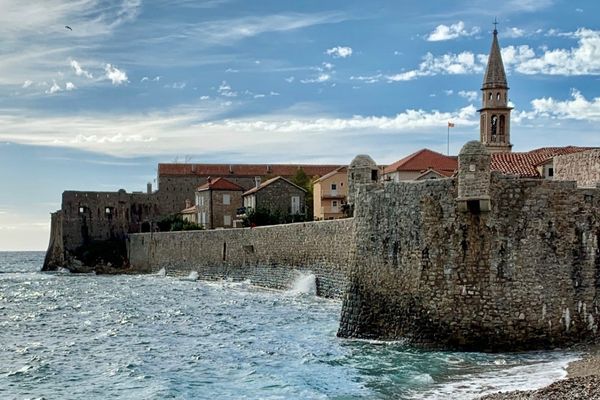Dark, pregnant clouds hung low over the small coastal town. Rain threatened. But my wife was hungry.
She did not, however, want to venture out into the sinister weather. So, she sent me to a nearby supermarket she’d spied earlier in the day as we’d wandered around Budva, a tiny, quaint, pretty, ancient Venetian-style town on Montenegro’s Adriatic coast.
I dashed across the street and figured I would take a short cut…which led me right past a new apartment building under construction, and which sported a large banner noting that a buyer could obtain a Montenegrin passport with their purchase.
“Hmmmm,” I noted mentally as I scampered through the early droplets of what was about to be a torrential downpour. “That’s kinda cool. I could definitely live here. And I get that second passport.”
I gave the idea no more thought during that trip because, well, I was in Budva to get married to Yulia, and I had other pressing matters to occupy my noggin.
But I have returned to the moment every now and again since that stormy night in December 2020.
If you’ve been reading these dispatches for a while, you’ll know that Yulia and I, while we love our life in Prague, are contemplating a move to a coastal location somewhere in Europe. Prospective destinations range from Portugal to Greece.
We’ve grown quite fond of Adriatic countries because they’re relatively inexpensive, English is widely spoken, and local languages are generally close enough to Russian and Czech that Yulia, who is a native Russian speaker and quite good at Czech too, can pretty easily understand them.
And, well, they’re just really pretty countries.
Montenegro is not only coastal, it’s mountainous. It’s a seaside-resort beach destination for Europeans in the summer…and a mountainside-resort ski destination for Europeans in winter.
The so-called “citizenship-by-investment” program makes Montenegro even more attractive for someone who has the money to spend on property here.

These citizenship-by-investment programs are popular all over the world. They’re among the easiest ways—though also among the most expensive—to quickly gain citizenship, which comes packaged with a passport.
All that’s required is buying property of a minimum value, either commercial or residential, and sometimes committing a bit more money to the state. With that, you’re granted citizenship, with which you can secure a second passport.
It’s a way that non-Europeans regularly gain citizenship in Europe, one of the most desirable continents because European passports routinely rank among the very best in the world. Nineteen of the top 25 passports globally are European. (Montenegro is not among those 25, yet. But it is pushing for acceptance into the European Union, which is possible by 2025. At that point, a Montenegrin passport is quite likely to shoot up the rankings and become one of the best to own.)
Thing is, Montenegro’s citizenship-by-investment plan goes away at the end of 2022, and there’s no indication that it will be replaced. Which means we’re in the final stretch for applying to one of the lowest-cost citizenship-by-investment programs in Europe: €250,000 in government-approved developments in the mountains in the north (think: ski resort areas)…or €450,000 for approved developments along the coast. There’s also a €200,000 donation to the government’s development fund.
That’s a pricey sum, yes. But there are those who can afford it and are looking for an option that gives them entry into Europe.
Other European destinations can be double that amount or more. Italy and Spain are €500,000. Portugal, once a low-cost leader, is €500,000 as well, but the most popular regions are off limits now, including Lisbon to Porto and almost all of the Algarve beach towns in the south. Malta is €690,000. Austria is €3 million.
Assuming Montenegro ultimately decides to renew its program in the run-up to EU accession—or particularly afterward, when the passport is a full-on EU passport—it seems quite likely the cost will rise sharply.
For anyone looking for a citizenship-by-investment passport in Europe, now is the moment to begin the process in Montenegro, before one of Europe’s most cost-effective options goes away.
And if you don’t want to commit that amount of money to getting a second passport in Europe, there are lots of other ways to get one, including options that are low-cost or even free. I’ll be writing more about those soon…
Not signed up to Jeff’s Field Notes?
Sign up for FREE by entering your email in the box below and you’ll get his latest insights and analysis delivered direct to your inbox every day (you can unsubscribe at any time). Plus, when you sign up now, you’ll receive a FREE report and bonus video on how to get a second passport. Simply enter your email below to get started.
